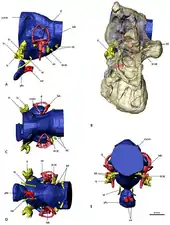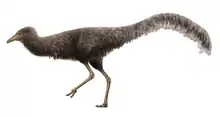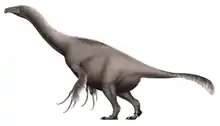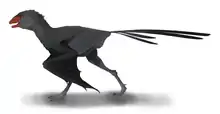Nothronychus
Nothronychus (meaning "slothful claw") is a genus of therizinosaurid theropod dinosaurs that lived in North America during the Late Cretaceous period. The type species, Nothronychus mckinleyi, was described by James Kirkland and Douglas G. Wolfe in 2001. It was recovered near New Mexico's border with Arizona, in an area known as the Zuni Basin, from rocks assigned to the Moreno Hill Formation, dating to the late Cretaceous period (mid-Turonian stage), around 91 million years ago. A second specimen, described in 2009 as a second species, Nothronychus graffami, was found in the Tropic Shale of Utah, dating to the early Turonian, between one million and a half million years older than N. mckinleyi.
| Nothronychus | |
|---|---|
.jpg.webp) | |
| Reconstructed skeleton of N. mckinleyi | |
| Scientific classification | |
| Kingdom: | Animalia |
| Phylum: | Chordata |
| Clade: | Dinosauria |
| Clade: | Saurischia |
| Clade: | Theropoda |
| Superfamily: | †Therizinosauroidea |
| Family: | †Therizinosauridae |
| Genus: | †Nothronychus Kirkland & Wolfe, 2001 |
| Type species | |
| †Nothronychus mckinleyi Kirkland & Wolfe, 2001 | |
| Other species | |
| |
Nothronychus were bulky herbivorous theropods with wide, sloth-like hip (resembling that of the non-related ornithischians), four-toed feet with all four toes facing forward, elongated necks and prominent arms with sharp claws. Both species were similar in dimensions, 4.2 m (14 ft) in length and weighing approximately 800 kg (1,800 lb). N. graffami was slightly robust than N. mckinleyi though.
History of discovery

The first fossil evidence later attributed to Nothronychus was discovered by a team of paleontologists working in the Zuni Basin of New Mexico at the Haystack Butte site, Moreno Hill Formation. A therizinosaur ischium (a hip bone) had originally been mistaken for a squamosal, a part of the skull crest of the newly discovered ceratopsian Zuniceratops. However, closer examination revealed the true identity of the bone, and soon more parts of the skeleton were found. The New Mexico team, led by paleontologists Jim Kirkland and Doug Wolfe, published their find in the Journal of Vertebrate Paleontology on 22 August 2001, making it the type specimen of the new species Nothronychus mckinleyi.[1] The Arizona Republic newspaper, however, was first to announce the name on 19 June 2001, in a column by R.E. Molnar. The generic name, Nothronychus, is derived from Greek νωθρός (nothros, meaning slothful) and ὄνυξ (onyx, meaning claw). The specific name, mckinleyi, honours rancher Bobby McKinley on whose land the fossil findings were made. The holotype, specimen MSM P2106, consists of very sparse skull fragments, a braincase, some vertebrae and parts of the shoulder girdle, forelimbs, pelvis and hindlimbs.[1]

A second, more complete specimen, UMNH VP 16420, was discovered from the Tropic Shale Formation (dating to the early Turonian stage) of southern Utah in 2000 by Merle Graffam, a resident of Big Water, Utah. The area around Big Water had been subject to several expeditions by teams from the Museum of Northern Arizona (MNA), and was known for its abundance of marine reptile fossils, especially plesiosaurs.[2] During part of the late Cretaceous period, the region had been submerged under a shallow sea, the Western Interior Seaway, and preserves extensive marine deposits. Graffam's initial discovery (a large, isolated toe bone) came as a surprise to colleagues, as it clearly belonged to a land-dwelling dinosaur, rather than a plesiosaur. However, the location of the bone at the time would have been nearly 100 kilometers from the Cretaceous shoreline. An excavation of the area by an MNA crew revealed more of the skeleton, and the scientists found that it was a therizinosaur, and the first example of that group to be found in the Americas. All previous therizinosaur fossils had come from China and Mongolia.[1] Between both species, N. graffami is the most complete but lacks the skull.[3][4]
The Utah specimen studied by the MNA team was found to be closely related to N. mckinleyi, though it differed in build (being heavier) and age (about half a million years older).[2] The MNA specimen was first announced in two 2002 talks during the 54th meeting of the Rocky Mountain Geological Society of America.[5][6] It was later discussed in an issue of Arizona Geology as a distinct species from N. mckinleyi, but not named.[2] The specimen was classified and named as the new species Nothronychus graffami by Lindsay Zanno and colleagues in the journal Proceedings of the Royal Society B on 15 July 2009. N. graffami was named for Graffam, who discovered the original specimens.[3] A reconstructed skeleton of N. graffami went on display at the MNA in September 2007.[2] In 2015, Hedrick and colleagues conducted a large osteological revision of both species and their respective specimens concluding that Nothronychus was one of the most complete and well-known therizinosaurids.[7]
Description

The genus Nothronychus can be distinguished from other therizinosaur taxa based on the distinctly subcircular obturator process; an elongated obturator foramen towards the bottom; the contact area between pubis and ischium is restricted to the upper half of the obturator projection; deep cut between towards the bottom facet of the obturator process and frontal ischial shaft.[7] Both species, N. mckinleyi and N. graffami, were similar in size with equal sized humeri (upper arm) (41.5 cm (415 mm) and 42.4 cm (424 mm) respectively), covering 4.2 m (14 ft) in length and about 800 kg (1,800 lb) in weight.[7][8] Nothronychus were ponderous animals with large "pot-bellied" abdomens, long necks, and stocky hindlimbs with four-toed feet. The arms were relatively large with dexterous hands equipped with up to 30 cm (300 mm) long curved and sharply-pointed claws on their fingers. In addition, the tail was reduced in length but more flexible. N. mckinleyi was different from N. graffami in being slightly less robust as well as details of the tail vertebrae, and a more bent ulna (lower arm bone).[7]
Classification
Nothronychus were members of the Coelurosauria, the theropod group composed mainly by carnivorous dinosaurs. However, more specifically, Nothronychus form part of the sub-group Maniraptora, theropods which evolved into partial omnivores and, in the case of Nothronychus and their family, plant-eaters.[3] Nothronychus mckinleyi was in 2001 assigned to the Therizinosauridae given the derived features of the genus.[1] In 2010, Lindsay E. Zanno performed a large and comprehensive analysis of the Therizinosauria. The cladistic analysis performed recovered both N. mckinleyi and N. graffami as a sister group.[4] Most of the data provided by Zanno was used by Hartman and collagues in 2019 during an extensive phylogenetic analysis for the Coelurosauria. Nothronychus was recovered as a therizinosaurid taxon with both species in derived positions. Below are the obtained results for the Therizinosauridae:[9]
| Therizinosauridae |
| |||||||||||||||||||||||||||||||||||||||||||||||||||||||||||||||||||||
Paleobiology

In 2018, the holotype braincase of Nothronychus mckinleyi was re-examined by Smith and colleagues updating numerous basicranial and soft-tissues aspects. They noted that the braincase has particularly large pneumatic chambers on the sensorial areas, suggesting that the increased tympanic systems would result in optimal low frequency sound reception, possibly infrasound, and in complex social behavior. The enlarged cochlea and presence of enlarged pneumatic chambers near the middle ear also supports this insight. Smith and colleagues established an average hearing frequency of 1100 to 1450 Hz and upper limits of 3000 to 3700 Hz. They stated however, that these estimates could be slightly exaggerated. Also, N. mckinleyi retained elongated semicircular canals in the ear, which are more related to an active, predatory life-style. This trait indicates that most therizinosaurids (possibly all therizinosaurs) retained the ancestral, carnivorous ear configuration−previously suggested for Erlikosaurus. Finally, based on Erlikosaurus, N. mckinleyi may have had a relatively horizontal head posture, which is associated with overlapping visual fields and binocular vision, given the orientation of the horizontal semicircular canal relative to the horizontal orientation of the occipital condyle.[10]
See also
References
- Kirkland, J. I.; Wolfe, D. G. (2001). "First definitive therizinosaurid (Dinosauria; Theropoda) from North America". Journal of Vertebrate Paleontology. 21 (3): 410−414. doi:10.1671/0272-4634(2001)021[0410:fdtdtf]2.0.co;2. JSTOR 20061971.
- Gillete, D. D. (2007). "Therizinosaur—Mystery of the Sickle-Claw Dinosaur" (PDF). Arizona Geology. 37 (2): 1−6.
- Zanno, L. E.; Gillette, D. D.; Albright, L. B.; Titus, A. L. (2009). "A new North American therizinosaurid and the role of herbivory in predatory dinosaur evolution". Proceedings of the Royal Society B. 276 (1672): 3505−3511. doi:10.1098/rspb.2009.1029. JSTOR 30244145. PMC 2817200. PMID 19605396.
- Zanno, L. E. (2010). "A taxonomic and phylogenetic re-evaluation of Therizinosauria (Dinosauria: Maniraptora)". Journal of Systematic Palaeontology. 8 (4): 503–543. doi:10.1080/14772019.2010.488045.
- Albright, L. B.; Gillete, D. D.; Titus, A. L. (2002). "New records of vertebrates from the Late Cretaceous Tropic Shale of Southern Utah". Paleontological Research in Grand-Staircase Escalante National Monument and Surrounding Area I. Archived from the original on 2011-06-08.
- Gillete, D. D.; Albright, L. B.; Titus, A. L.; Graffam, M. H. (2002). "Discovery and excavation of a therizinosaurid dinosaur from the Upper Cretaceous Tropic Shale (Early Turnoian), Kane County, Utah". Paleontological Research in Grand-Staircase Escalante National Monument and Surrounding Area I. Archived from the original on 2011-06-08.
- Hedrick, B. P.; Zanno, L. E.; Wolfe, D. G.; Dodson, P. (2015). "The Slothful Claw: Osteology and Taphonomy of Nothronychus mckinleyi and N. graffami (Dinosauria: Theropoda) and Anatomical Considerations for Derived Therizinosaurids". PLOS ONE. 10 (6): e0129449. Bibcode:2015PLoSO..1029449H. doi:10.1371/journal.pone.0129449. PMC 4465624. PMID 26061728.
- Paul, G. S. (2016). The Princeton Field Guide to Dinosaurs (2nd ed.). Princeton, New Jersey: Princeton University Press. pp. 162−168. ISBN 9780691167664.
- Hartman, S.; Mortimer, M.; Wahl, W. R.; Lomax, D. R.; Lippincott, J.; Lovelace, D. M. (2019). "A new paravian dinosaur from the Late Jurassic of North America supports a late acquisition of avian flight". PeerJ. 7: e7247. doi:10.7717/peerj.7247. PMC 6626525. PMID 31333906.
- Smith, D. K.; Sanders, R. K.; Wolfe, D. G. (2018). "A re-evaluation of the basicranial soft tissues and pneumaticity of the therizinosaurian Nothronychus mckinleyi (Theropoda; Maniraptora)". PLOS ONE. 13 (7): e0198155. doi:10.1371/journal.pone.0198155. PMC 6067709. PMID 30063717.






.png.webp)



.jpg.webp)





